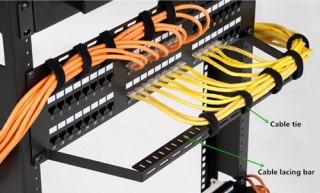Marketing
Cable Lacing Bar for Good Cable Management
In recently years, more and more data centers and server rooms feature high density and large capacity, in which there are a large number of copper or fiber patch cables used for connecting the whole network. In order to ensure the performance of the whole network, there is no doubt that these patch cables should be connected with no error. Any improper cable management would directly result in cable damage and network failure that can cause data transmission error, performance issue and system downtime. But the fact is that the work of managing these massive patch cables is a quite difficult task, which is easily in error. Then what can we do to achieve good cable management and ensure network performance? This paper will mainly study the cable lacing bar, which is designed for achieving good cable management.
Cable Lacing Bar Introduction
It is well known that cable ties (like nylon cable ties and velcro cable ties), patch panels (like copper patch panels and fiber patch panels) and J-Hook enables better cable management in high density network, which can be also found it in my last paper. Except these tools, is there any other tool that can also achieve good cable management? The answer is cable lacing bar in this paper, which is as important as the previous three tools mentioned above.
The cable lacing bar, also known as lacer bars, is a common kind of cable management tool, made of metal material, which offers support and and management of the massive patch cables. With the use of cable lacing bar, the pressure created by the cable connections can be greatly relieved, the bend radius of the patch cable can be stably controlled and the cabling can be highly improved to a neat one. At present, there are various kinds of cable lacing bars with different features to satisfy the increasing requirements of cabling network, for instance, round lacing bars, rectangular lacing bars, round lacing bars with Offset and l-shaped lacing bars, etc. For the structure of common cable lacing bar, you can learn it from the following figure.
In general, the width of the cable lacing bar is always 19 inches, while its height can be alternative, 1U or 2U. It can be mounted above, below, behind, or in front of your network devices, easily found in racks (between switches and patch panels) or enclosures. As for its practical application, you are highly suggested to bind the patch cables to the cable lacing bar by the use of cable ties like black velcro cable ties in the figure above. You only need to mount the cable lacing bar to the rack, and then use the cable tie to bind the patch cables to the cable lacing bar.
Cable Lacing Bar Advantages
What makes the cable lacing bar so widely used for managing the patch cables? Compared to other cable management tools, what are the advantages of the cable lacing bar? Firstly, using the cable lacing bar to manage the patch cables can greatly save space, because it uses less than 1U space, or doesn’t occupy any space if installed in front of or behind your network device. Hence, the valuable space can be saved for installing other network devices. Secondly, there are numerous cable lacing points, almost covering the whole cable lacing bar, which enables easier cabling. Thirdly, the cable lacing bar can relieve the strain of cables which plays an important role in high density cabling network. Fourthly, it can promotes the bend radius of the patch cables, so that the risk such as slower data transmission rates or broken patch cables can be reduced or even avoided.
Conclusion
As we move to more and more complicated network, the cable management takes an much more important role than ever before. With the advantages of relieving pressure created by the cable connections, promoting the bend radius of the patch cables and saving space, the cable lacing bar is an ideal choice for efficient and neat cable routing. Hence, it would be better to choose a suitable kind of cable lacing bar to manage your patch cables if your network features high density and large capacity.
Post je objavljen 16.02.2017. u 04:07 sati.
